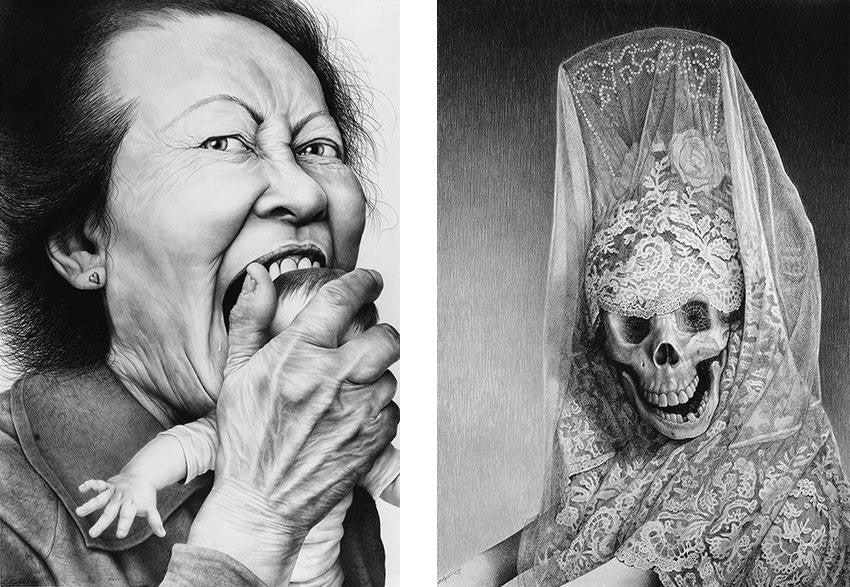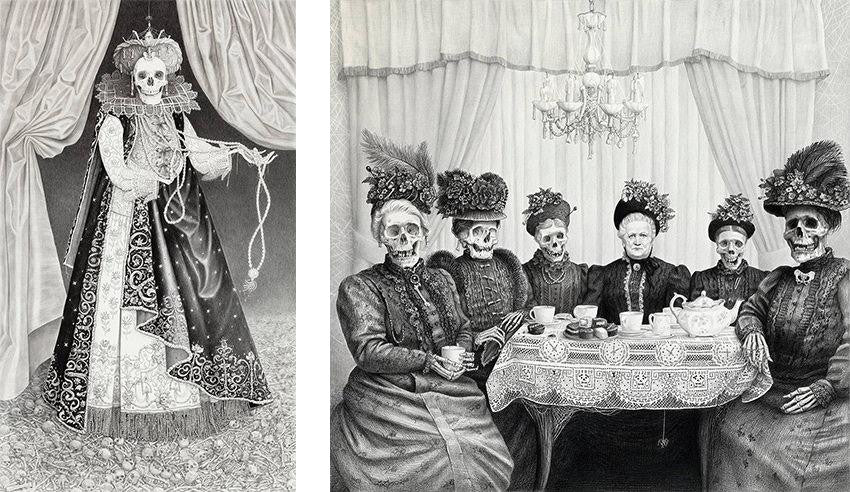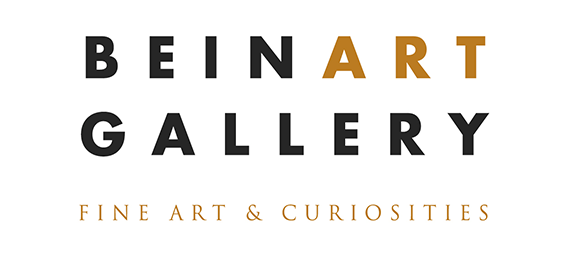
“Love Bite” 2002 – Charcoal & pencil drawing, 54"x38" & “Lady Death” 2004 – Pencil drawing, 23"x16".
It is impossible to capture in a few brief sentences the immensity of what Laurie Lipton achieves in her art. Her work is excruciatingly detailed and complex, and nothing in it is to be taken for granted: let your eyes pass lightly over a gown, for example, and you’ll miss that the trim is made of tiny skulls. Lipton’s dedication to drawing has yielded skills that alone are reason to rejoice in her work. But that would by far shortchange the impact of her unflinching commentary on the complexities of modern life, both in society at large and for individuals.
“I have always doggedly pursued my personal passions, which is probably why my drawings are so weirdly unique.” —Laurie Lipton
Julie Antolick Winters: Although you were born in the United States, you lived for many years abroad before moving to Los Angeles a few years ago. Was there anything that surprised you about living in the States again?
Laurie Lipton: Yes. I left in 1975 and came back to 1955. Things have gotten very retro here: reversing women’s rights, bigotry, teaching Creationism in some schools… it’s as if I got into a time warp!

“Round and Round” 2012 – Charcoal & pencil drawing, 37"x53".
JAW: I was interested to learn that you use magnifying glasses for some of your work. What tool(s), if any, do you have in your studio that might surprise a guest?
LL: I invented a stick that hooks over my drawing table so that I never have to touch the paper and smudge my work.
JAW: Very broadly speaking, there seems to have been a progression in your work from personal or interpersonal—pieces involving family dynamics, for example—to a fanning out to society as a whole. What can you tell us about what has guided your thematic choices?
LL: I think it’s the result of aging. When you’re a teenager or in your early 20’s, family issues and self-identity are important. When your Self has formed and you’ve figured out who and what you are, the next logical step is to look outside of yourself to society and the world in general.

"La Luz" 2011 - Charcoal & pencil drawing, 35"x24.5" & “On” 2013 - Charcoal & pencil drawing, 92"x67.5".
JAW: You have created images that you acknowledge can be difficult for some viewers. Certainly there is a lot of pain and anxiety in some of your pieces. Because of how long it takes you to create your drawings, do you ever find it difficult to spend that time with some of your images?
LL: Never. My imagery has never bothered me. My work amuses me immensely.
JAW: Are there images, either in the work of others or simply in life, that you find hard to bear?
LL: I can’t stand to look at images of animals suffering in any way. I felt the same as a child when I saw the horses being “shot” in westerns. It never bothered me that the cowboys were being shot, by the way. I guess it’s because I’ve been acclimatized to seeing people being tortured and killed in film and on TV.

"Network” 2014 - Charcoal & pencil drawing, 67.5"x104".
JAW: Tell us about your preference for black and white over color in your work.
LL: Yes, I can paint (in case you were wondering), but colour distracts from the image, and it is the image that is my primary concern. Black and white is the colour of memory, ghosts, and old TV shows. When I saw the black and white photos of Diane Arbus as a teenager, I realised that this was what I wanted. Her pictures looked otherworldly, frozen in time, disturbing. Adding colour to them would have destroyed the atmospheric pressure inherent in black and white. I wanted the stark, bare essence of the colourless. I wanted my work to feel haunted.

"Motoring" 2009 - Charcoal & pencil drawing, 29"x39".
JAW: You have noted that at the time you were in art school, what was in vogue was abstract splashes of color rather than representational work. How did you cope with being in art school and being discouraged to pursue the art you found meaningful?
LL: Fortunately, I had parents who encouraged me as a child, so when professors and art students told me that figurative work went “out” in the Middle Ages, and that I should use “pencil for pencil’s sake” (i.e., just make marks, not images), I had the self-confidence and conviction to ignore everyone’s advice and just get on with following my vision. I have never taken fads or fashion into account when doing my work, or tried to copy anyone else. I have always doggedly pursued my personal passions, which is probably why my drawings are so weirdly unique.

"Info Glut" 2010 - Charcoal & pencil drawing, 20"x23" & "Pandora's Box" 2011 - Charcoal & pencil drawing, 39"x28".
JAW: Considering that you had to teach yourself to draw in the style which has brought you so much success, would you consider your time in art school to have been helpful at all?
LL: Yes. It gave me time. I didn’t have to go out into the cold, cruel world and support myself. I had use of the university library and was with people my own age who were also interested in art. My freshman year roommate became a very dear friend of mine, and she happens to live across the street from me now in West Hollywood.

"The Umpteenth Anniversary" 2010 - Charcoal & pencil drawing, 16"x23".
JAW: So much of your work is social commentary, on topics varying from overconsumption of materials and media to politics. Yet I’m not sure I can come up with any examples of your work that are squarely on the positive end of the spectrum: what we’re doing right as opposed to what we’re doing wrong. Is this a deliberate choice, and if not, what do you suppose accounts for this?
LL: I only draw about the things that concern me. When I was a child I used to sit alone for hours and draw about all the aspects of school that I hated, all the wrongs I felt, all the anger and frustration that was bottled up inside of me. It helped me to cope and to understand. Unsettling art, whether it is in books, music, or pictures, is an attempt to comprehend life’s trials and tribulations. Pretty, nice, non-confrontational, “positive” art serves a purpose, too… but I don’t connect to it on any deep level and I don’t wish to waste my time doing it.

"Queen of Bones” 2009 - Charcoal & pencil, 30.7"x51.5" & ”Bone China” 2010 - Charcoal & pencil, 21.5"x23".
JAW: Are there any topics that you’ve wanted to address in your work that you elected for some reason to stay away from? For example, you are an atheist, but I’m not aware of any pieces of yours that directly address religion.
LL: As a matter of fact, I have done many pieces on spirituality and worked a number of years for a private library in Holland that has the largest collection of books on alchemy and mysticism in Europe. However… I usually just draw what I want to. I was never censored as a child, and I do not tend to censor myself now as an adult.
JAW: Although so much of your work is dark in nature, a sly humour runs through many of your pieces. Is that something you aim for, or does it simply arise out of how you view the world?
LL: I’m a New Yorker and can’t help myself. My family was always laughing, even when things got tragic. We always saw the absurdity of life. I think it’s healthy not to take yourself too seriously. I am VERY healthy, as I don’t take myself seriously at all.

"Reality TV” 2009 - Charcoal & pencil drawing, 32"x41".
JAW: Of your move back to the States, you have said, “I… think this is a very interesting time to be back in the USA. The Empire is in decline, and I want to try to record its descent.” Tell us about that: what drives that impulse? Do you see your art as in some way an effort to wake people up now or as a record for future generations?
LL: I am not vain enough to think that I can wake people up or teach future generations. I am merely attempting to translate what I see, think, and feel and trying to communicate “reality” as I experience it. What drives that impulse? Good question. All I know is that I am impelled to draw, that I’ve been drawing for over 50 years, and that I will hopefully draw till I drop. Art has inspired and changed my life. If my work lives beyond me and does that for someone else, then that would be a beautiful bonus.

"Wired” 2013 - Charcoal & pencil drawing, 82"x64" & "Climax” 1993 - pencil drawing, 38.7"x26".
This interview was written by Julie Antolick Winters for the Beinart Collective in 2014.
Julie Antolick Winters is a writer and editor residing in the state of Maryland, USA, in a small city near Washington, D.C. Julie cowrote the introduction for Black Magick: the Art of Chet Zar and co-copyedited this book and Kris Kuksi: Divination and Delusion for Beinart Publishing. She has also been conducting artist interviews for the Beinart Collective & Gallery since 2010. In addition to her work for the Beinart Gallery, she edits science articles and books, writes poetry and practices the art of negotiation with her son.




 Cart
Cart



